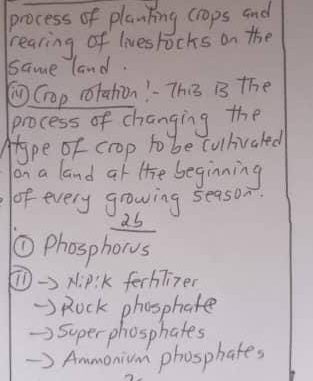
Agricultural science | Waec Expo | Waec agric science answers | How to get agric questions | waec runs 2023 | legit runs | Sure Answers expo | Agricultural practical| Waec science runs
AGRIC OBJECTIVE!
01-10: CDCBCABCAD
11-20: BCCBCACCAC
21-30: CBABACCABD
31-40: ACDCBDADDA
41-50: CBADACCBCA
(1a)
(PICK ANY ONE
Credit in agricultural finance involves the provision of loans that must be repaid by borrowers, while subsidies are grants or direct payments provided by the government to support specific agricultural objectives without the requirement of repayment.
OR
Credit is a situation whereby sellers allow buyers to take possession of goods and services and pay later while subsidy is a situation whereby part of the money a buyer is meant to pay for good is paid for by the government
(1b)
(PICK ANY FIVE)
(i) Fertilizers
(ii) Seeds
(iii) Livestock feed
(iv) Research and development
(v) Crop insurance
(vi) Training and Education
(vii) Agricultural machinery
(viii) Energy
(ix) Pesticides and Herbicides
(x) Labour
(1c)
(PICK ANY SIX)
(i) Tire Inspection
(ii) Regular oil changes
(iii) Belt inspection and adjustment
(iv) Hydraulic system maintenance
(v) Fuel filter replacement
(vi) Greasing and lubrication of moving parts
(vii) Cleaning and replacing air filters
(viii) Inspecting and tightening bolts and connections
(1d)
(PICK ANY FIVE)
(i) Read and understand the operator’s manual
(ii) Wear appropriate protective gear
(iii) Conduct pre-operation checks
(iv) Always check the water level
(v) Avoid loose clothing and jewelry
(vi) Use safety guards and shields
(vii) Clear the work area
(viii) Follow safe refueling practices like turning off the machinery before refueling
(2ai)
Agricultural ecology is the study of how plants, animals, and the environment interact within agricultural systems. It focuses on understanding the relationships between agricultural practices, the health of ecosystems, and the well-being of both humans and nature.
Or use this
(2ai)
Agricultural ecology is a field of study that examines the ecological processes and interactions within agricultural systems. It involves understanding the relationships between plants, animals, microorganisms, and their environment in the context of agriculture.
(2aii)
An Ecosystem refers to the natural environment in which crops, livestock, and other organisms interact with each other and with their surroundings. It includes the plants, animals, microorganisms, soil, water, and air within a farming area.
Or
An Ecosystem refers to the complex network of interactions between living organisms (plants, animals, microorganisms) and their physical environment (soil, water, air) within a specific agricultural area. It involves the flow of energy, the cycling of nutrients, and the interdependence of different components.
(2bi)
{Choose any two}
(i) plants.
(ii) animals.
(iii) decomposers.
(2bii)
{Choose any three}
(i) Light
(ii) air
(iii) soil
(iv) nutrients.
(2c)
– Ensure ventilation.
– Guard against pests.
– Keep bags elevated.
– Maintain cleanliness.
– Follow FIFO system.
(2d)
– Petunias
– Marigolds
– Begonias
– Geraniums
(3ai)
Rootknot nematode/Meloidogyne spp.
(3aii)
Nematodes are soil borne so are transmitted through soil movement and run-off water
(3aiii)
(i)Enlargement of certain cells of the roots in the form of knots
(ii)Retarded growth
(3aiv)
[PICK ANY TWO]
(i)Crop rotation
(ii)Use resistant varieties
(iii)Use nematicides such as furadan
(iv)Use of African marigold (biological control)
(v)Heavy doses of organic matter application
(vi)Soil sterilization
(3bi)
FERTILIZER APPLICATION
(i) Excessive application of fertilizers can cause soil acidity
(ii) Excessive of it’s application can also reduce the activities of the soil organisms
(iii) Excessive application may also hinder the growth of crops
(3bii)
CLEAN CLEARING
(i)It leads to reduction of organic matter
(ii)It leads to loss of soil nutrients
(iii)It upsets the ecosystem or ecological balance
(3biii)
OVERGRAZING
(i)It exposes the soil to erosion
(ii)It destroys the soil structure
(iii)It causes poor growth and regenerative capacity of vegetation
(3c)
(i)It is used for crop production
(ii) Livestock production
(iii) Fisheries
(4a)
(i) Clearing
(ii) Tillage
(iii) Ridging
(iv) Planting
(4b)
(PICK ANY THREE)
(i) It serves as food
(ii) It can be utilized as a source of animal feed
(iii) Cassava tubers can be processed into various food products
(iv) Cassava plants are utilized in certain regions for their ability to improve soil fertility, control erosion, and prevent nutrient depletion.
(v) In some traditional medicinal practices, cassava tubers and leaves are used for their potential therapeutic properties
(vi) Cassava starch can be used to produce biodegradable packaging materials
(vii) Cassava tubers have industrial applications in various sectors like in the textile industry for sizing fabrics and improving their quality.
(4ci)
Expected number of yam plants = Number of planting spots per hectare * Total area of the farmland
Expected number of yam plants = 10,000 * 1.5 = 15,000
Therefore, the expected number of yam plants on the 1.5 hectares of farmland would be 15,000 plants.
(4cii)
Total weight = Expected number of yam plants * Average weight of each yam tuber
Total weight = 15,000 * 3.5 kg = 52,500 kg
Therefore, the total weight of the yam tubers harvested on the 1.5 hectares of farmland would be 52,500 kilograms (or 52.5 metric tons).
(4d)
Diet refers to the overall composition and combination of feeds and ingredients that an animal consumes over a certain period WHILE a ration, on the other hand, is a specific amount or quantity of feed that is provided to an animal during a single feeding event or within a specific time period, typically a day.
5a
Fill in the Gap.
I)diarrhea
ii. Clean and disinfect pens
iii. prevent overcrowding
Iv. Swine influenza
V. proper ventilation
Vi.bio security measures
vii. Fever, lethargy, and anorexia
viii.vaccination
Ix. culling of infected animals
x. disinfection of premises
5b.
i.To lay eggs
ii.To release pheromones
5bii.
Two functions of the worker bee are:
i. To gather nectar and pollen
ii.To care for the young
5c.
1. To retain moisture
2. To regulate temperature
3. To prevent pests
4.To reduce odour
5. To prevent rainwater from entering
COMPLETED
✅✅

Leave a Reply